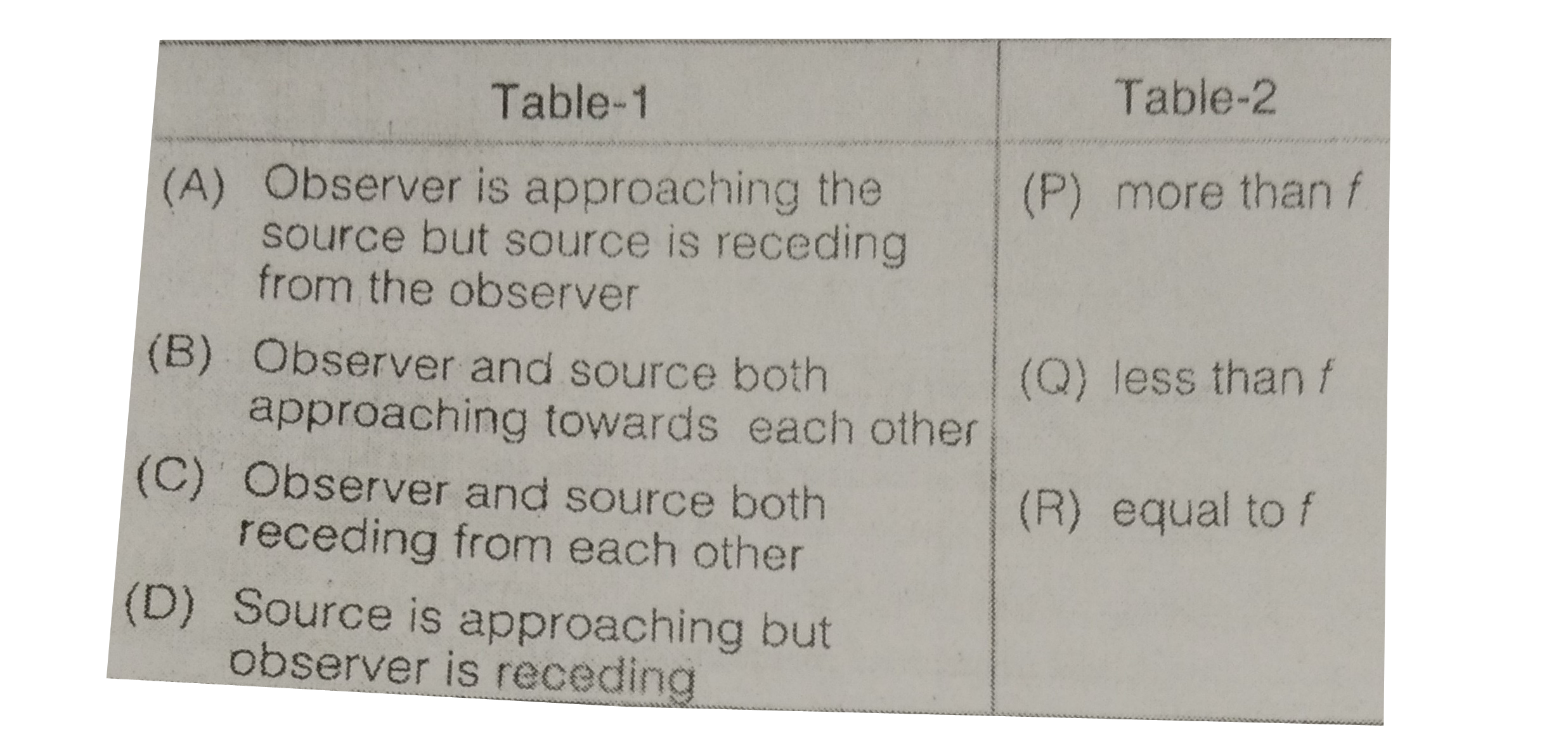An observer moves towards a stationary source of sound with a speed 15th of the speed of sound. The wavelength and frequency of the source emited are λ and f, respectively. The apparent frequency and wavelength recorded by the observer are, respectively-
(a) f,1.2λ
(b) 0.8f,0.8λ
(c) 1.2f,1.2λ
(d) 1.2f,λ
f,1.2λ
0.8f,0.8λ
1.2f,1.2λ
1.2f,λ
The correct Answer is:b
To solve the problem step-by-step, we will apply the principles of the Doppler effect for sound waves.
Step 1: Understand the given parameters
- The speed of sound is denoted as V.
- The speed of the observer is 15 of the speed of sound, which can be expressed as:
Vobserver=V5
- The frequency of the source is f and the wavelength is λ.
Step 2: Determine the apparent frequency using the Doppler effect formula
The formula for the apparent frequency f′ when the observer is moving towards a stationary source is given by:
f′=f⋅V+VobserverV
Since the source is stationary, its velocity is 0. Therefore, we can substitute the values into the formula:
f′=f⋅V+V5V
Step 3: Simplify the expression for apparent frequency
Now, simplify the expression:
f′=f⋅V+V5V=f⋅V(1+15)V=f⋅(1+15)=f⋅65
This simplifies to:
f′=1.2f
Step 4: Determine the apparent wavelength
The wavelength is related to frequency and speed of sound by the equation:
λ′=Vf′
Since the speed of sound V remains constant and the frequency has changed, we can express the new wavelength as:
λ′=V1.2f
Now, since the original wavelength is given by:
λ=Vf
We can relate the new wavelength to the original wavelength:
λ′=V1.2f=11.2⋅Vf=11.2⋅λ
This simplifies to:
λ′=0.833λ(approximately 0.8λ)
Conclusion
Thus, the apparent frequency and wavelength recorded by the observer are:
- Apparent frequency: 1.2f
- Apparent wavelength: 0.8λ
The correct answer is option (d): 1.2f,λ.
- The speed of sound is denoted as V.
- The speed of the observer is 15 of the speed of sound, which can be expressed as:
Vobserver=V5
- The frequency of the source is f and the wavelength is λ.
The formula for the apparent frequency f′ when the observer is moving towards a stationary source is given by:
f′=f⋅V+VobserverV
Since the source is stationary, its velocity is 0. Therefore, we can substitute the values into the formula:
f′=f⋅V+V5V
Now, simplify the expression:
f′=f⋅V+V5V=f⋅V(1+15)V=f⋅(1+15)=f⋅65
This simplifies to:
f′=1.2f
The wavelength is related to frequency and speed of sound by the equation:
λ′=Vf′
Since the speed of sound V remains constant and the frequency has changed, we can express the new wavelength as:
λ′=V1.2f
Now, since the original wavelength is given by:
λ=Vf
We can relate the new wavelength to the original wavelength:
λ′=V1.2f=11.2⋅Vf=11.2⋅λ
This simplifies to:
λ′=0.833λ(approximately 0.8λ)
Thus, the apparent frequency and wavelength recorded by the observer are:
- Apparent frequency: 1.2f
- Apparent wavelength: 0.8λ
Similar Questions
Speed of sound wave is v. If a reflector moves towards a stationary source emitting waves of frequency f with speed u, the wavelength of reflected waves will be
View SolutionA sound source has frequency f. Source and observer both have same speed.For the apparent frequency observed by observer match the following.
 View Solution
View Solution
Knowledge Check
- Question 1 - Select One
A sound source is moving towards a stationary observer with 1/10 of the speed of sound. The ratio of apparent to real frequency is
A109B(109)2C(1110)2D1110 - Question 2 - Select One
A source of sound producing wavelength 50 cm is moving away from a stationary observer with (15)th speed of sound. Then what is the wavelength of sound received by the observer?
A55 cmB40 cmC60 cmD70 cm
An observer is approaching with a speed v , towards a stationary source emitting sound waves of wavelength λ0 . The wavelength shift detected by the observer is ( Take c= speed of sound )
View Solutionwhen a source of sound of frequency f crosses stationary observer with a speed vs(<< speed of sound v) , the apparent change in frequency Δf is given by
View Solution(A) : When a source moves towards a stationary observer, the speed of source relative to the observer remains unchanged.
(R): The apparent change in frequency is due to change in the wavelength brought by the motion of the source.View SolutionWhen the observer moves towards the stationary source with velocity, v1, the apparent frequency of emitted note is f1. When the observer moves away from the source with velocity v1, the apparent frequency is f2. If v is the velocity of sound in air and f1f2 = 2,then vv1 = ?
View SolutionAn observer starts moving with unifrom acceleration a towards a stationary sound soure of frequency fo. As the observer approaches the source ,the apparent frequency f heard by the observer varies with time t as
View SolutionA source of sound and an observer are approaching each other with the same speed, which is equal to (110) times the speed of sound. The apparent relative change in frequency of source is
View Solution

